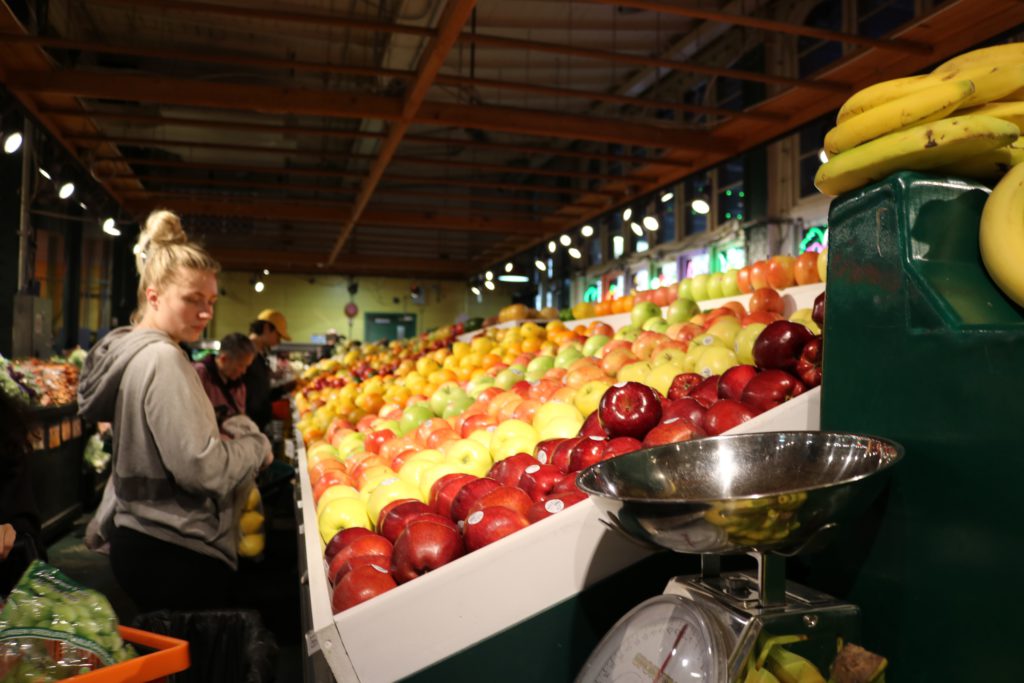Food Insecurity: The Forgotten Impact of Financial Toxicity
By Laurie Hatch, MS RD
One in five cancer survivors in the U. S. struggle to meet the costs of housing, transportation, and foods¹. Women with lower incomes and less education are particularly stressed about their ability to pay cancer treatment costs and pay down medical debt. Deborah, a 55-year-old single mother of two teens, became disabled due to her breast cancer and had barely afforded the costs of both her treatments and filling the pantry and refrigerator for herself and her two sons. One day while receiving ongoing chemotherapy for breast cancer, she confided in me that although she had food stamps and stretched her dollars with coupons, she could not afford food to nourish herself in the same way that she had in the past. Her boys were growing, and her financial resources were stripped due to increasing food costs. A choice between affording her co-pays and medications or groceries was looming larger in her mind.

Deborah is one of thousands faced with choosing to pay for nutritious food or continue treatment. One of the most challenging tasks for a cancer dietitian is educating a survivor with a meager food budget how to acquire healthier foods. Critically, a 5-10% weight loss can prevent survivors from receiving life-saving therapies; consistent good nutrition and weight stability is key. Applying for food stamps, instructions for shopping at the food bank and discount stores and limiting food waste are among skills in the toolkit of registered dietitians use to help survivors experiencing food insecurity, but ultimately, survivors must skillfully navigate grocery aisles stocked with increasingly more costly foods. Unfortunately, because insurance does not cover the cost of nutritional services in cancer centers, survivors like Deborah may not have access to specialized guidance for food insecurity.
The Cost of Eating Well. Forgotten and buried beneath the cost of cancer treatment co-pays, prescriptions, specialist visits, imaging tests, and unpaid bills is the high cost of eating well. With a 10% increase in food costs over the past year, more survivors are struggling to afford nourishing food. According to the USDA, a moderate weekly food bill for a woman 51-70 years old is $72.30. To stay within food budgets, some survivors may choose less nutritious foods compromising nutritional well-being, particularly if they also are feeding growing kids and teens². Nutritional health for survivors requires high quality protein from meats, beans, eggs, and fish. Fruits and vegetables provide much needed vitamins, minerals, and fiber. But energy-dense foods, or unhealthy foods, tend to be cheaper and taste good. Chips, frozen dinners and pizza, packaged rice and pasta mixes are inexpensive, require less preparation than meals made with supplies from your pantry but are often high in salt and lower in nutritional quality. Meat is the highest cost food group at the checkout with fruits and vegetables a close second, and both are necessary.
For survivors facing food insecurity, here are a few tips:
- Plan your meals for the week. Create a shopping list based on your healthy meal plan using low-cost, nutrient dense recipes. Creating a list based on recipes and a quick look at pantry stock prevents last-minute unhealthy additions to your shopping cart. Grocery mobile apps offer valuable savings.
- Go for frozen and canned fruits and vegetables. Save money without sacrificing nutritional value with canned and frozen.
- Buy in bulk. When possible, purchase food staples for the pantry and freezer in larger quantities. Consider buying your meat in bulk and freezing portions until ready to use.
- Become a food label detective. Ingredient lists reveal the true story about a food while labels are food marketing enticing you to buy a food using words like healthy, organic, and natural to influence your purchase. Start by looking at the first three ingredients listed on the label for whole foods and limit those that have refined grains, added sugars, and hydrogenated/processed oils.
- Skip organic. Choosing organic foods increases costs and does not assure nutritional advantage. Conventionally grown fruits and vegetables have the same nutritional value as organic foods. Keep in mind that products labeled as “contains organic ingredients” does not mean it is nutritionally superior.
- Make 2, freeze 1. Embrace the practice of cooking once, eating twice. Save money by making two meal-size portions of healthy meals and freezing one for later. Embrace leftovers for both cost-saving and better flavor for the next meal.
As you join your loved ones around the table this year, consider making a donation to a survivor who may be struggling to feed his or her family. By paying their utilities, car payment or house payment, you're helping them free up funds for groceries.
About the author
 Laurie Hatch is a registered dietitian with nearly 2 decades working with cancer survivors and their families and owner of Food Is Medicine RD, LLC. As both cancer dietitian and breast cancer survivor, she has written a textbook and journal, In the Pink: A Breast Cancer Survivor’s Guide to a Healthier Life, due for release in 2023. Her passion is enhancing the lives of other survivors by introducing them to using food as medicine, acquiring a healthier weight, and moving more and sitting less. She lives with her husband in Denver, Colorado. You can find her on Facebook @lauriehatch, Instagram @foodismedicinerd_cancer and at foodismedicinerd.com.
Laurie Hatch is a registered dietitian with nearly 2 decades working with cancer survivors and their families and owner of Food Is Medicine RD, LLC. As both cancer dietitian and breast cancer survivor, she has written a textbook and journal, In the Pink: A Breast Cancer Survivor’s Guide to a Healthier Life, due for release in 2023. Her passion is enhancing the lives of other survivors by introducing them to using food as medicine, acquiring a healthier weight, and moving more and sitting less. She lives with her husband in Denver, Colorado. You can find her on Facebook @lauriehatch, Instagram @foodismedicinerd_cancer and at foodismedicinerd.com.
References
1. “The Costs of Cancer Survivorship.” American Cancer Society. Accessed August 23, 2023. https://www.fightcancer.org/policy-resources/costs-cancer-survivorship-2022.
2. “USDA Food Plans: Cost of Food.” USDA Food and Nutrition Services. US Department of Agriculture. Accessed August 23, 2023. www.fns.usda.gov/cnpp/usda_food_plans.
